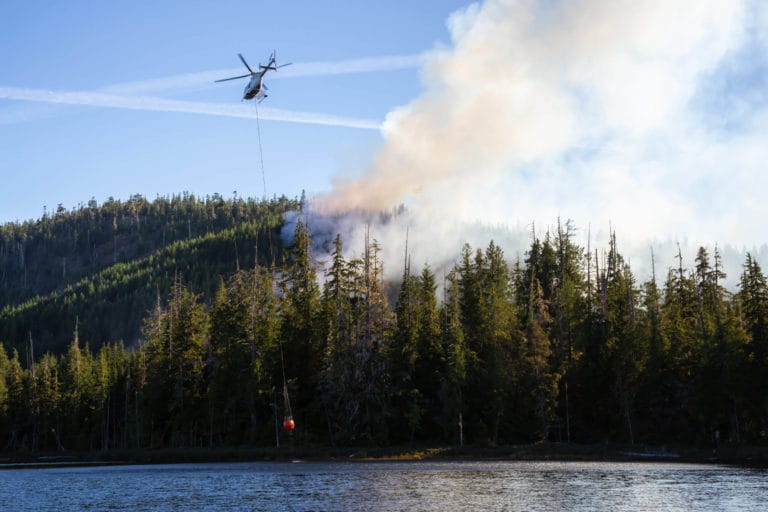Yes, brush clearing can significantly help prevent wildfires. Dense brush and overgrown vegetation act as fuel, increasing the risk and intensity of wildfires. By removing excess brush, dead plants, and other combustible materials, brush clearing reduces the fuel load, creating defensible space around properties and natural areas.
Here are a few things we’d be talking about regarding brush clearing and wildfires:
- Role of Brush in Wildfires
- Benefits of Brush Clearing in Wildfire Prevention
- Considerations for Effective Brush Clearing
- The Role of Controlled Burns in Brush Clearing
- Challenges and Limitations of Brush Clearing
Role of Brush in Wildfires
Brush refers to the dense collection of shrubs, bushes, and other small vegetation that is commonly found in wildfire-prone areas. These vegetative materials, when dry, can serve as fuel for wildfires, allowing them to spread quickly and intensify. Brush can act as ladder fuel, allowing the fire to climb from the ground to the tree canopies, increasing the fire’s potential to cause damage.
Additionally, brush often accumulates dead plant material, creating an even greater fuel load for fires. As a result, understanding the role of brush in wildfires is vital for developing effective prevention strategies.
Benefits of Brush Clearing in Wildfire Prevention
Reduces Fuel Load
One of the primary benefits of brush clearing is the reduction of fuel load. By removing or thinning out the brush, there is less flammable material available for wildfires to ignite and spread. This can significantly decrease the intensity and speed at which fires spread, making them easier to control and suppress.
Creates Defensible Space
Brush clearing also plays a crucial role in creating defensible space. Defensible space is an area around buildings or structures that is intentionally cleared of vegetation and debris to create a buffer zone. This space acts as a barrier, reducing the likelihood of a wildfire reaching the structures. By strategically clearing brush in this manner, the risk of property damage and loss is greatly decreased.
Limits Fire Spread
Another benefit of brush clearing is its ability to limit the spread of wildfires. When brush is cleared from certain areas, such as firebreaks or roadways, it creates natural barriers that can impede the advance of fires. This buys time for firefighters to respond and implement suppression tactics, ultimately preventing the fire from spreading further.
Enhances Firefighter Safety
Clearing brush can greatly enhance firefighter safety during wildfire operations. By reducing the presence of dense brush, firefighters have better access to the fire and can maneuver more effectively. It also decreases the risk of firefighters becoming entrapped or cut off by advancing flames. Brush clearing allows for safer and more efficient firefighting efforts.
Preserves Ecological Balance
While the removal of brush may seem counterintuitive to preserving the environment, it can actually contribute to maintaining ecological balance. When brush becomes overgrown, it can hinder the growth of native plant species, disrupt natural habitats, and increase the risk of disease or pest outbreaks. By strategically and responsibly clearing brush, the ecosystem can thrive by promoting a healthier balance of vegetation and wildlife.
Considerations for Effective Brush Clearing
While brush clearing can be highly beneficial in wildfire prevention, it is essential to consider certain factors for its effectiveness.
Firstly, it is crucial to conduct proper planning and assessment before initiating brush clearing operations. Factors such as topography, vegetation types, and proximity to sensitive ecosystems should be taken into account.
Additionally, the timing of brush clearing is essential. Avoiding the dry season and conducting operations during more favorable weather conditions can minimize the risk of unintentionally igniting fires during the process. Furthermore, regular maintenance and monitoring of cleared areas are necessary to ensure ongoing effectiveness.
The Role of Controlled Burns in Brush Clearing
In addition to mechanical methods, controlled burns are often used as a tool for brush clearing and wildfire prevention. Controlled burns involve purposefully setting fires under controlled conditions, allowing for the reduction of excess brush and vegetation.
These controlled burns can help eliminate accumulated fuel loads and promote the growth of fire-resistant vegetation. By managing the vegetation through controlled burns, the risk of uncontrolled and destructive wildfires can be significantly reduced.
Challenges and Limitations of Brush Clearing
While brush clearing is an effective strategy for wildfire prevention, it does come with certain challenges and limitations.
Firstly, the process of brush clearing can be labor-intensive, time-consuming, and expensive. It may require the use of heavy machinery or manual labor, depending on the size and density of the brush. Additionally, accessing remote or steep terrain can pose logistical challenges.
Furthermore, there may be environmental concerns associated with excessive brush clearing. Some species of wildlife rely on brush for habitat or food sources, so striking a balance between wildfire prevention and ecological preservation is crucial.
Lastly, brush clearing is not a one-time solution. Vegetation naturally regrows, so regular maintenance and monitoring are necessary to ensure long-term effectiveness.


